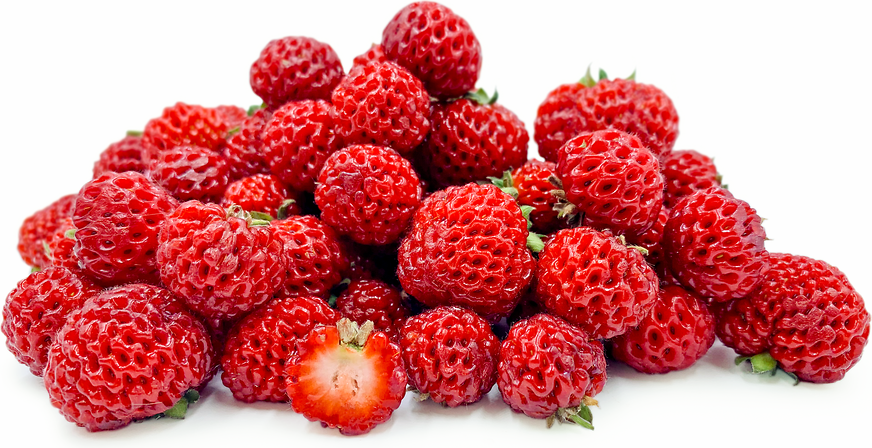


Strasberries
Estimated Inventory, lb : 0
Description/Taste
Strasberries are small, red fruits, measuring approximately 15 to 25 millimeters in diameter. While their round shape and size are reminiscent of raspberries, its visual characteristics more closely resemble those of a strawberry, featuring a glossy red exterior adorned with a green stem. Its surface is dotted with divots filled with seeds, encasing its round body. Internally, the Strasberry transitions from a vibrant red outer flesh to a white inner core, filled with small, edible seeds, akin to strawberries. This internal flesh may present a slightly firmer texture than that of a typical strawberry. The aroma and flavor of Strasberries are sweet and fruity, with their taste further distinguished by a subtle tartness and a rich, juicy quality.
Seasons/Availability
Strasberries are available from late spring through early summer.
Current Facts
The scientific name given to all strawberries, including distinctive varieties like the Strasberry, is Fragaria ananassa. Strasberries are a hybrid, a result of combining two wild strawberry species: Fragaria chiloensis, found throughout the Americas, and Fragaria virginiana, native specifically to North America. Despite the Strasberry's appearance, which suggests a blend between a strawberry and a raspberry, it is genetically a pure strawberry. Strasberries represent a type of wild strawberry that has been carefully bred through generations to exhibit raspberry-like features. However, crossing strawberries with raspberries is not possible, given the considerable differences between their respective plants.
Nutritional Value
Similar to conventional strawberry varieties, the Strasberry is a good source of calcium, phosphorus, and vitamins B and C. Consuming a serving of Strasberries can provide up to 75% of your daily vitamin C requirements. This means that they can contribute to energy balance and support the health of your bones, teeth, hair, and skin.
Applications
Strasberries can be used in most of the same ways as regular strawberries, though they are significantly more fragile and are typically harvested with the calyx, or leaf and stem, still attached. Strasberries can be incorporated into both sweet and savory dishes, whether eaten raw or cooked. They can be enjoyed fresh, either whole or sliced, mixed with other fruits, and tossed into salads. Strasberries can be pureed or cooked down into a compote, syrup, or glaze, and used in pies, ice creams, sorbets, and cocktails. Compatible flavor pairings include vanilla, oranges, grapefruit, lemons, limes, watermelon, cream, yogurt, ginger, brown sugar, chiles, bacon, and cheeses such as blue cheese, feta, and chevre. Strasberries also pair well with herbs like basil, mint, lemon verbena, fennel, and lavender. To clean, gently rinse the berries in a water basin and let them air dry in a single layer to prevent mold formation. For storage, keep them refrigerated at 35°F to 39°F.
Ethnic/Cultural Info
Once on the brink of extinction, Strasberries found refuge in the gardens of amateur growers in the former German Democratic Republic. They were later reintroduced to commercial markets by Dutch farmer and breeder Hans de Jongh, leader of the Beekers Berries Breeding program. The exotic appeal of the Strasberry has captured the attention of ice cream vendors looking to create unique flavors. Ice cream has now emerged as one of the most popular ways to enjoy Strasberries.
Geography/History
Strasberries have a history spanning over 100 years, with their origins tracing back to South America in the 1900s before being reintroduced in the Netherlands in 1996. This fruit thrives in temperate climates with cool winters and mild summers, with optimal growing temperatures ranging from 60°F to 80°F. Strasberries prefer manure-rich soil that retains moisture without becoming overly wet. As the plants cannot self-pollinate, they need to be planted close to ordinary strawberry plants to ensure pollination. The Netherlands has emerged as the leading cultivator and commercial producer of Strasberries. The fruit is increasingly featured on European restaurant menus, particularly in Britain, where there's a trend towards reviving forgotten produce. Due to its low yield and delicate cultivation requirements, the Strasberry remains a niche product. It is more commonly found at farmers' markets or specialty stores within suitable climates rather than in commercial grocery stores.
Recipe Ideas
Recipes that include Strasberries. One
| Ice Cream Recipes |
|
Homemade Strasberry Ice Cream |




